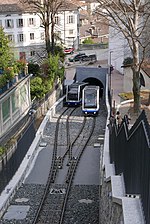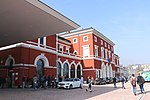Lugano FLP railway station
Ferrovie Luganesi stationsRailway stations in Switzerland opened in 1912Railway stations in TicinoTransport in Lugano

Lugano FLP railway station (Italian: Stazione di Lugano FLP) is a railway station in the municipality of Lugano, in the Swiss canton of Ticino. It is the eastern terminus of the 1,000 mm (3 ft 3+3⁄8 in) gauge Lugano–Ponte Tresa line of Ferrovie Luganesi. The station is located in the forecourt of Swiss Federal Railways' main-line Lugano railway station. The station and line opened in 1912. Between 1990 and 1992 the Lugano FLP station was renovated and expanded. The street level building is now a restaurant, although the platforms remain in use at the lower level.
Excerpt from the Wikipedia article Lugano FLP railway station (License: CC BY-SA 3.0, Authors, Images).Lugano FLP railway station
Via Clemente Maraini, Circolo di Lugano ovest
Geographical coordinates (GPS) Address External links Nearby Places Show on map
Geographical coordinates (GPS)
| Latitude | Longitude |
|---|---|
| N 46.0045 ° | E 8.9475980555556 ° |
Address
Lugano FLP
Via Clemente Maraini
6901 Circolo di Lugano ovest, Molino Nuovo
Ticino, Switzerland
Open on Google Maps







